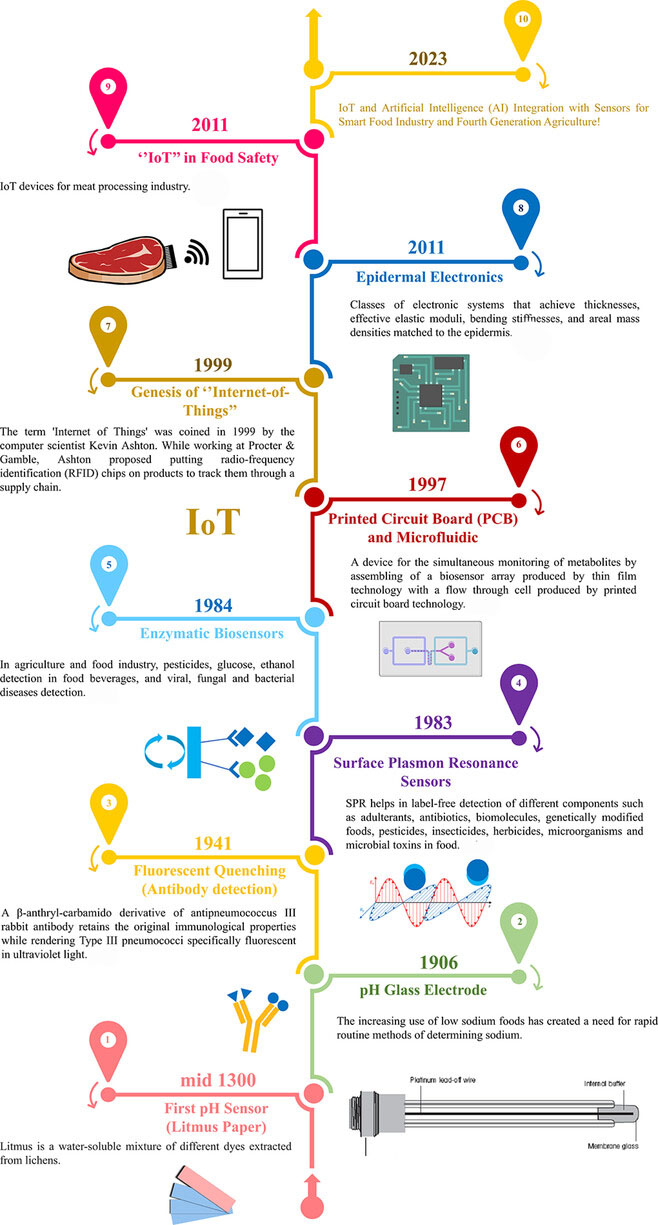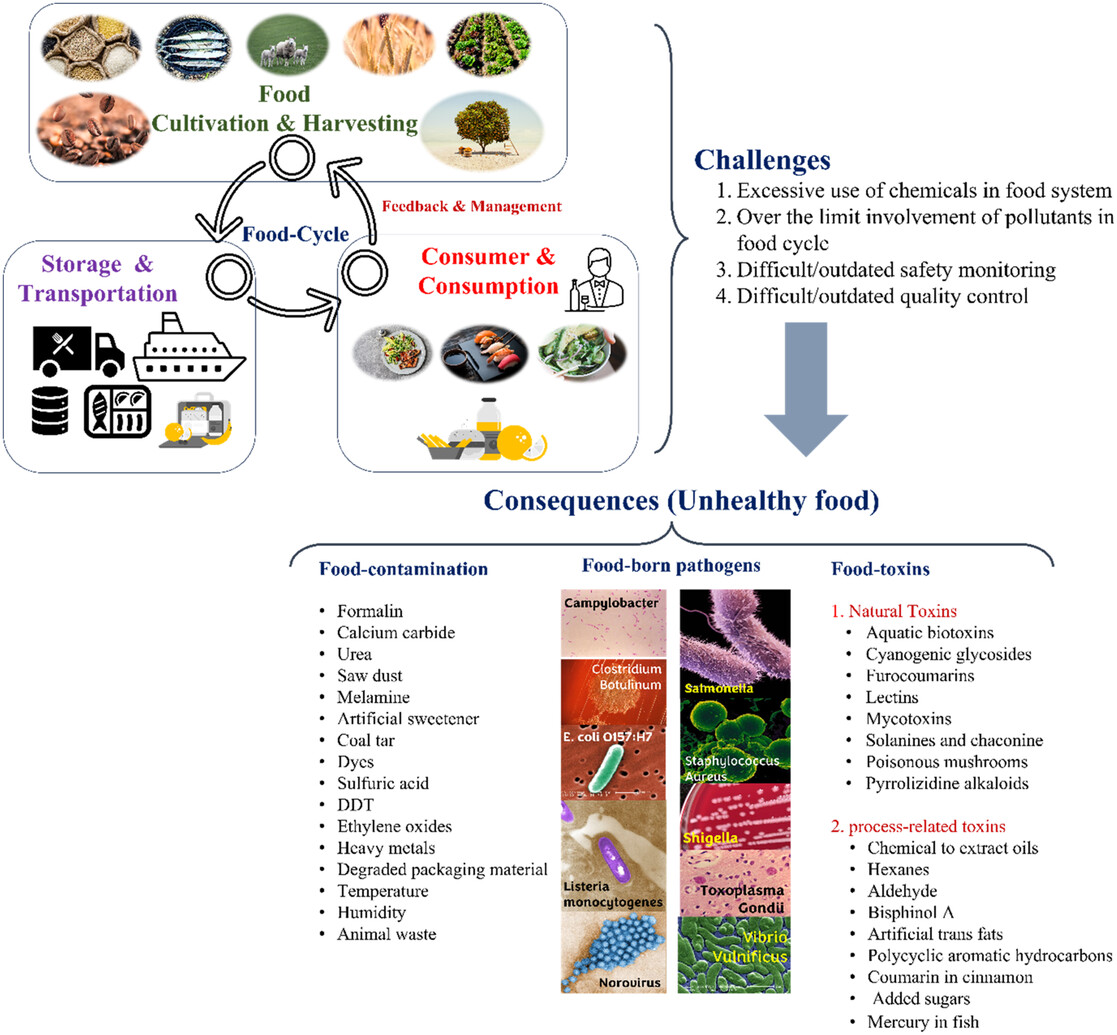| Dec 26, 2023 | |
Nanofabrication meets Internet-of-Things for advanced smart farming |
|
| (Nanowerk Spotlight) Researchers have long sought to enhance food and agricultural practices through advanced technologies like sensors and wireless data transfer. Persistent challenges around efficiently monitoring crop and food quality have slowed progress. Now, emerging nanomanufacturing techniques and Internet of Things (IoT) connectivity may soon unlock smarter, sustainable farming powered by an influx of field data. | |
| Advances in sensor technology have introduced a diverse array of instruments for food and agriculture. These include sensors for detecting specific pathogens in food, moisture levels in soil, and even volatile organic compounds released by plants under stress. Such sensors help in early detection of spoilage or disease, enabling timely intervention. The integration of these sensors with IoT platforms allows for real-time monitoring and data analysis, enhancing the efficiency of agricultural practices. | |
 |
|
| A timeline figure covering year-wise improvement of sensor technologies and IoT devices for both food and plant sensing. (© Wiley-VCH Verlag) | |
| However, handheld devices and other portables remain limited, as tedious lab-based tests still dominate in agriculture and food production chains today. This leads to critical delays from the time samples are gathered until key decisions can be made, resulting in food waste, lower yields and environmental impacts. | |
| Powerful innovations outside the sector have opened new possibilities. The manufacturing advances underpinning wearable biosensors for healthcare are now being adapted for veterinary and agricultural applications. Paired with wireless networks and cloud data analysis enabled by strides in IoT platforms and artificial intelligence (AI), tiny, mounted instruments potentially allow constant crop monitoring at the source. | |
| A recent publication in Advanced Intelligent Systems ("Internet of Things-Enabled Food and Plant Sensors to Empower Sustainability") presents a comprehensive review of two key areas: firstly, the deployment of cost-effective, high-performance sensors to improve food safety, quality, plant growth, and disease management; and secondly, the application of IoT-enabled sensors that empower farmers, stakeholders, and the agro-food industry through swift testing and predictive analytics derived from sensor-generated data, utilizing AI. | |
Automation of Used Tools Remains a Key Barrier |
|
| While food industry tools have gotten cheaper, faster and more mobile, end users still face a serious automation deficit when trying to integrate sensor data. Crop problems are often spotted when it’s too late to use new gene editing and microbiome management techniques that could otherwise neutralize issues at early stages. | |
| Legacy agriculture technology vendors have signaled standalone instruments remain their priority, leaving the sector reliant on researchers and startups to retrofit connectivity. Major sensor manufacturers do hype “smart” farming broadly. Yet closer analysis shows their offerings still require substantial hands-on data collection, with IoT networking treated as an aspiration more than an actionable strategy. | |
| The innovation bottleneck has kept farmers skeptical. Growers hesitate purchasing newer devices if it means more work syncing data, especially with tight budgets. Researchers at universities and cutting-edge companies have stepped up pilots of fully integrated monitoring with the help of eager early adopters. But lacking reliable automation to replace manual tasks at commercial scale, most projects never expand beyond trials. | |
| While the potential of IoT in agriculture is immense, technological limitations pose significant challenges. Issues such as data overload, where farmers receive more information than they can effectively use, and concerns over data accuracy and reliability remain prevalent. Additionally, the need for robust data management systems that can handle large volumes of data seamlessly is critical for the practical application of these technologies in the field. | |
| Importantly, the successful implementation of IoT and sensor technologies in agriculture hinges on their integration with existing practices. This includes ensuring compatibility with current equipment and processes and providing training for farmers and agricultural workers. The technology must be user-friendly and adaptable to various agricultural settings, allowing for smooth transition and minimal disruption to established practices. | |
 |
|
| Food cycle and associated challenges (contaminants, toxins, and pathogens) to maintain safety and quality, needed for health wellness. (© Wiley-VCH Verlag) (click on image to enlarge) | |
Wearables Crossover from Medical Labs |
|
| Now outside expertise from healthcare technology specialists focused on easy and automated biosensing looks poised to fulfill the promise. Their flexible, durable, nanofabricated sensor strips can stick directly onto produce, livestock and key infrastructure. Integrated wireless connectivity enables these peel-and-stick monitors to transmit biomarker information straight to the cloud without needing workers shuffling data. | |
| AI algorithms churn through the flood of field data as it streams in, distilling insights and alerting managers via apps only when critical intervention thresholds are crossed. This avoids "data fatigue," a common complaint from farmers given heaps of sensor readings but little helpful guidance for what to actually do next. Hands-free analysis prevents wasted time trying to interpret overwhelming reports. | |
| The biometric breakthroughs enabling round-the-clock patient monitoring outside hospitals are nearly ready for farming fields. Market researchers project agricultural IoT investments will triple globally within five years. Dispatches from recent industry conferences also highlight interconnectivity as the top priority for sensor tech developers now eyeing agriculture and food businesses as a key future vertical. Venture capital funding for startups commercializing continuous crop monitoring surged 40% year-over-year through the first half of 2022. | |
Moving Toward High-Precision Food and Agriculture |
|
| Before crossing over into the food and agriculture world, wearable and implantable medical sensors faced barriers similar to what farming technology struggles with today. Doctors would not adopt monitors that complicated their workload by producing unusable data. Streamlining the process to limit supervision necessary for constant tracking proved essential to drive adoption. Medicine also overcame initial patient discomfort and skepticism regarding safety and effectiveness over time as consistency and accuracy improved. | |
| Now agriculture hopes to follow healthcare’s roadmap toward persistent sensing. Demonstration farms aim to convince hesitant farmers through real life proof that round-the-clock crop and soil surveillance can work at commercial volumes without disrupting operations. Developers intent on responsibly scaling new monitoring tools prioritize building trust as device reliability keeps improving. | |
| The economic and social implications of adopting advanced sensor and IoT technologies in agriculture are profound. On one hand, these technologies promise increased efficiency, reduced waste, and improved crop yields, leading to potential economic benefits. On the other hand, there's a need to consider the impact on labor markets and the accessibility of such technologies for small-scale farmers. Balancing technological advancement with social and economic equity will be key in the sustainable evolution of agriculture. | |
| With historic expertise barriers falling, food and agriculture seem poised for transformation through applied technology. Continuous fine-grained field data promise to enable true precision around growing and distribution, rather than relying on educated guesses from limited manual samples. Still in early days, researcher caution more integration work ahead before declaring sensors and connectivity can fulfill lofty promises to fully revolutionize farming and food production. Clearly though, the building blocks look ready for something groundbreaking. | |
 By
Michael
Berger
– Michael is author of three books by the Royal Society of Chemistry:
Nano-Society: Pushing the Boundaries of Technology,
Nanotechnology: The Future is Tiny, and
Nanoengineering: The Skills and Tools Making Technology Invisible
Copyright ©
Nanowerk LLC
By
Michael
Berger
– Michael is author of three books by the Royal Society of Chemistry:
Nano-Society: Pushing the Boundaries of Technology,
Nanotechnology: The Future is Tiny, and
Nanoengineering: The Skills and Tools Making Technology Invisible
Copyright ©
Nanowerk LLC
|
|
|
Become a Spotlight guest author! Join our large and growing group of guest contributors. Have you just published a scientific paper or have other exciting developments to share with the nanotechnology community? Here is how to publish on nanowerk.com. |
|
